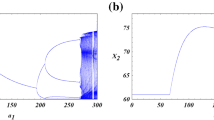Abstract
Previously, the authors proposed a formalization of renewable resources rational use problem based on the representation of controlled system as a discrete dynamical system. In the particular case of structured ecosystem described by Leslie’s binary model, despite its non-linearity, it turned out that all optimal controls preserving this system belong to the certain hyperplane. This paper explores the conditions under which the positive boundary of a feasible set of problem with so-called quasi-preserving controls also contain a part of some hyperplane. In the process, we used a generalization of classical concept of map irreducibility—the concept of local irreducibility. Statements about the influence of the irreducibility property of discrete dynamical system step operator on the properties of an feasible set positive boundary are proved.
Access this chapter
Tax calculation will be finalised at checkout
Purchases are for personal use only
Similar content being viewed by others
References
Allen, R., Basasibwaki, P.: Properties of age structure models for fish populations. J. Fish. Res. Board Can. 31, 1119–1125 (1974)
Boucekkine, R., Hritonenko, N., Yatsenko, Y.: Age-structured modeling: past, present, and new perspectives. In: Optimal Control of Age structured Populations in Economy. Demography, and the Environment, pp. 1–19. Routledge, London (2011)
De Lara, M., Doyen, L.: Sustainable Management of Natural Resources: Mathematical Models and Methods. ESE. Springer, Heidelberg (2008). https://doi.org/10.1007/978-3-540-79074-7
Getz, W.M., Haight, R.G.: Population Harvesting: Demographic Models of Fish, Forest, and Animal Resources. Princeton University Press, Princeton (1989)
Logofet, D.: Matrices and Graphs. Stability Problems in Mathematical Ecology. CRC Press, Boca Raton (2018)
Mazurov, V.D., Smirnov, A.I.: The conditions of irreducibility and primitivity monotone subhomogeneous mappings. Trudy Instituta Matematiki i Mekhaniki UrO RAN 22(3), 169–177 (2016). (in Russian)
Mazurov, V., Smirnov, A.: On the reduction of the optimal non-destructive system exploitation problem to the mathematical programming problem. In: Evtushenko, Y.G., Khachay, M.Y., Khamisov, O.V., Malkova, V., Posypkin, M. (eds.) OPTIMA-2017. CEUR Workshop Proceedings, vol. 1987, pp. 392–398 (2017)
Nikaido, H.: Convex Structures and Economic Theory. Academic Press, NY (1968)
Reed, W.J.: Optimal harvesting policy for an age specific population. Biometrics 36(4), 579–593 (1980)
Rowntree, L., Lewis, M., Price, M., Wyckoff, W.: Globalization and Diversity: Geography of a Changing World, 4th edn. Pearson, New York (2015)
Smirnov, A., Mazurov, V.: On existence of optimal non-destructive controls for ecosystem exploitation problem applied to a generalization of leslie model. In: Evtushenko, Y., Jaćimović, M., Khachay, M., Kochetov, Y., Malkova, V., Posypkin, M. (eds.) OPTIMA-2018. DEStech Trans. Comput. Sci. Eng. pp. 199–213 (2019). https://doi.org/10.12783/dtcse/optim2018/27933
Smirnov, A., Mazurov, V.: Generalization of controls bimodality property in the optimal exploitation problem for ecological population with binary structure. In: Jaćimović, M., Khachay, M., Malkova, V., Posypkin (eds.) OPTIMA-2019. CCIS, vol. 1145, pp. 206–221 (2020). https://doi.org/10.1007/978-3030-38603-0_16
Author information
Authors and Affiliations
Corresponding author
Editor information
Editors and Affiliations
Rights and permissions
Copyright information
© 2020 Springer Nature Switzerland AG
About this paper
Cite this paper
Smirnov, A.I., Mazurov, V.D. (2020). Feasible Set Properties of an Optimal Exploitation Problem for a Binary Nonlinear Ecosystem Model with Reducible Step Operator. In: Kochetov, Y., Bykadorov, I., Gruzdeva, T. (eds) Mathematical Optimization Theory and Operations Research. MOTOR 2020. Communications in Computer and Information Science, vol 1275. Springer, Cham. https://doi.org/10.1007/978-3-030-58657-7_23
Download citation
DOI: https://doi.org/10.1007/978-3-030-58657-7_23
Published:
Publisher Name: Springer, Cham
Print ISBN: 978-3-030-58656-0
Online ISBN: 978-3-030-58657-7
eBook Packages: Computer ScienceComputer Science (R0)




